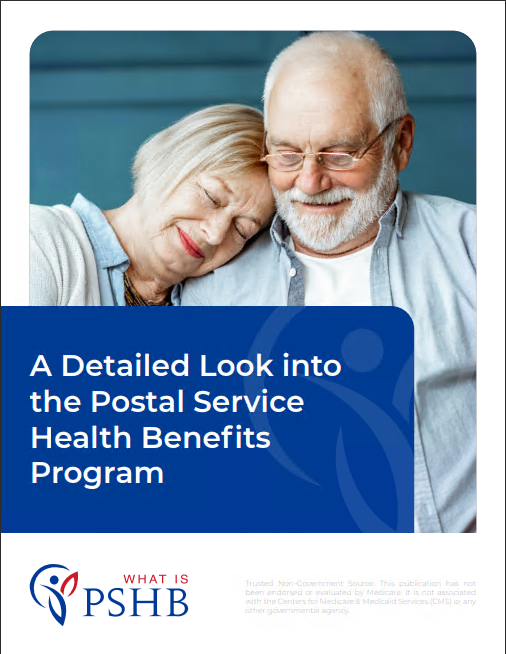Key Takeaways
-
The Postal Service Health Benefits (PSHB) Program does not affect other federal benefits such as FEGLI, FEDVIP, FLTCIP, or FSAFEDS.
-
Understanding how your non-health benefits work alongside PSHB helps you avoid confusion and make informed retirement and financial decisions in 2025.
PSHB: A Major Shift, But Not a Total Overhaul
As of January 1, 2025, the transition from the Federal Employees Health Benefits (FEHB) Program to the new Postal Service Health Benefits (PSHB) Program has taken full effect for USPS employees and retirees. While this is a major change to how your health insurance works, many other federal benefits remain untouched. It’s important to understand what PSHB affects—and what it doesn’t.
If you’re currently employed by the Postal Service or are a retiree, you may have questions about the broader implications of this switch. Here’s a breakdown of what you can still count on staying the same.
What PSHB Does Not Affect
PSHB only replaces FEHB as the health benefits program specifically for USPS employees, annuitants, and their eligible family members. The following federal benefits remain entirely separate from PSHB and are not impacted by your enrollment or participation.
1. Federal Employees’ Group Life Insurance (FEGLI)
FEGLI remains available to eligible Postal Service employees and retirees. Your coverage options, premiums, and enrollment rules remain governed by FEGLI regulations, not by PSHB.
-
Coverage continues based on the choices made during your career.
-
Retirement reductions and options for continuing coverage after separation remain unchanged.
-
Premiums increase with age, especially for Option B and C.
You don’t need to re-enroll or update your FEGLI just because you transitioned to PSHB.
2. Federal Employees Dental and Vision Insurance Program (FEDVIP)
FEDVIP is still in place for both USPS employees and retirees. If you’re enrolled in dental or vision insurance through FEDVIP, that coverage continues without disruption under the new PSHB environment.
-
No requirement to enroll in PSHB to maintain FEDVIP.
-
FEDVIP open season occurs annually alongside PSHB open season.
-
Separate premiums and coverage rules apply.
FEDVIP operates independently of your PSHB plan, so nothing changes here.
3. Federal Long Term Care Insurance Program (FLTCIP)
The FLTCIP is still available for those who were enrolled before the enrollment suspension that began in 2022. While FLTCIP remains on pause for new applicants, current enrollees continue to be covered.
-
The suspension of new enrollment continues through 2025.
-
Existing FLTCIP participants maintain their coverage and premium payments.
-
PSHB enrollment or changes have no impact on your long-term care benefits.
Even with the PSHB transition, your existing FLTCIP coverage continues uninterrupted.
4. Flexible Spending Accounts (FSAFEDS)
FSAFEDS lets USPS employees set aside pre-tax dollars to cover eligible medical or dependent care expenses. Enrollment in PSHB does not impact your eligibility for or participation in FSAFEDS.
-
Contributions are made through payroll deductions.
-
The 2025 contribution limit for healthcare FSAs is $3,300.
-
Plans that allow carryover let you keep up to $660 into 2026.
Note: Retirees are not eligible for FSAFEDS. This benefit is limited to actively working employees.
Benefits That Do Interact With PSHB
While many programs remain untouched, a few federal benefits and requirements do intersect with PSHB, especially in retirement or if you’re Medicare-eligible.
Medicare Part B Integration
Certain Medicare-eligible annuitants and family members are now required to enroll in Medicare Part B to maintain PSHB coverage. This change is significant and directly connected to PSHB implementation.
-
Applies to those who retired after January 1, 2025, and are eligible for Medicare.
-
Individuals who retired on or before January 1, 2025, are exempt from this requirement.
-
Exceptions apply for residents abroad and certain veterans.
Failure to enroll in Medicare Part B when required may result in loss of PSHB coverage.
Medicare Part D Prescription Drug Coordination
PSHB plans automatically include Medicare Part D drug coverage through an Employer Group Waiver Plan (EGWP) for Medicare-eligible annuitants.
-
Includes a $35 insulin cap and a $2,000 out-of-pocket maximum.
-
Enrollees benefit from a wider pharmacy network.
-
Opting out of this benefit results in loss of prescription drug coverage through PSHB.
This integration is automatic if you’re enrolled in both Medicare and PSHB.
Survivor Benefits and Eligibility
If you’re a retiree, your PSHB coverage may continue for your eligible survivors after your death—but only if survivor annuity benefits are elected.
-
Spouses or children eligible under a survivor annuity can maintain PSHB coverage.
-
If no survivor annuity is elected, family members lose eligibility.
-
Coverage continues as long as survivor benefits are received.
Planning for survivor coverage is a critical step if you’re nearing retirement.
What to Keep an Eye On During Open Season
From November to December each year, the PSHB Open Season allows you to make changes to your health plan. But this window does not apply to all your other benefits:
-
FEGLI: Changes can only be made during rare open seasons or with a qualifying life event.
-
FEDVIP: Changes are allowed during Open Season or after qualifying life events.
-
FSAFEDS: Requires re-enrollment every year during Open Season.
-
FLTCIP: Still suspended for new enrollees.
It’s essential to evaluate all your benefit programs during the Open Season period, even if changes aren’t allowed for every program.
Retirement Transitions and Your Benefits
When transitioning into retirement, the following timelines and considerations apply:
-
FEGLI: Coverage automatically reduces unless you elect to maintain it at full or partial value. Premiums are based on age.
-
FEDVIP: Coverage continues into retirement if premiums are paid.
-
PSHB: Automatically replaces FEHB in 2025 for annuitants unless a waiver is granted.
-
Medicare Part B: Required if you retired after January 1, 2025, and want to keep PSHB.
-
FSAFEDS: Ends at retirement.
Understanding these transitions ensures a smoother shift into retirement with fewer surprises.
What You Can Do Now
Here are some actions you can take today to make sure you’re on the right path:
-
Review your current coverage for all federal benefits.
-
Check if you’re subject to the Medicare Part B requirement under PSHB.
-
Confirm whether your survivor annuity elections align with your family’s needs.
-
Monitor Open Season timelines to make informed decisions.
-
Contact your benefits coordinator if you’re unsure about any interaction between programs.
Being proactive will help you avoid disruptions and maintain the benefits you’ve earned.
Staying Informed as PSHB Evolves
The PSHB Program is new and may evolve in future years. While most other benefits remain unaffected in 2025, policy changes and legislative updates could impact them down the line. Stay engaged by:
-
Reading official communications from USPS and OPM.
-
Keeping copies of your benefit elections.
-
Consulting with a licensed agent to help clarify how your benefits align.
Monitoring your benefits status regularly is key to ensuring full protection of your coverage.
Understanding the Big Picture Helps You Stay Prepared
While PSHB is a major development in your federal benefits, it doesn’t touch everything. Knowing where the lines are drawn—and which programs are entirely separate—gives you clarity and confidence moving forward. Whether you’re still working or have already retired, your other federal benefits remain intact and continue serving their purpose.
If you’re unsure how PSHB impacts your full benefits picture, it’s a good idea to speak with a licensed agent listed on this website who can provide professional guidance tailored to your situation.






